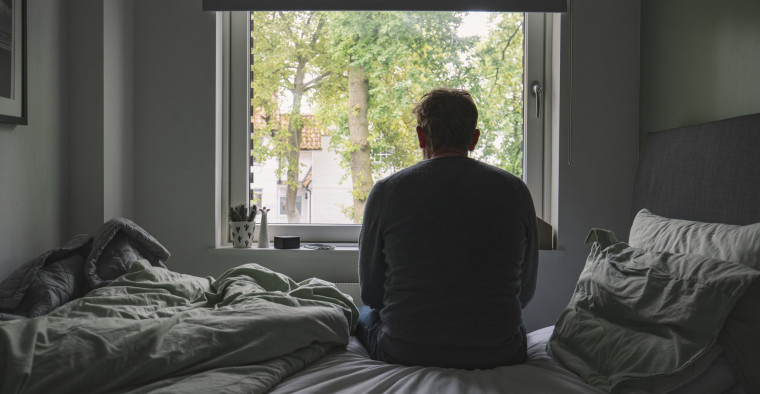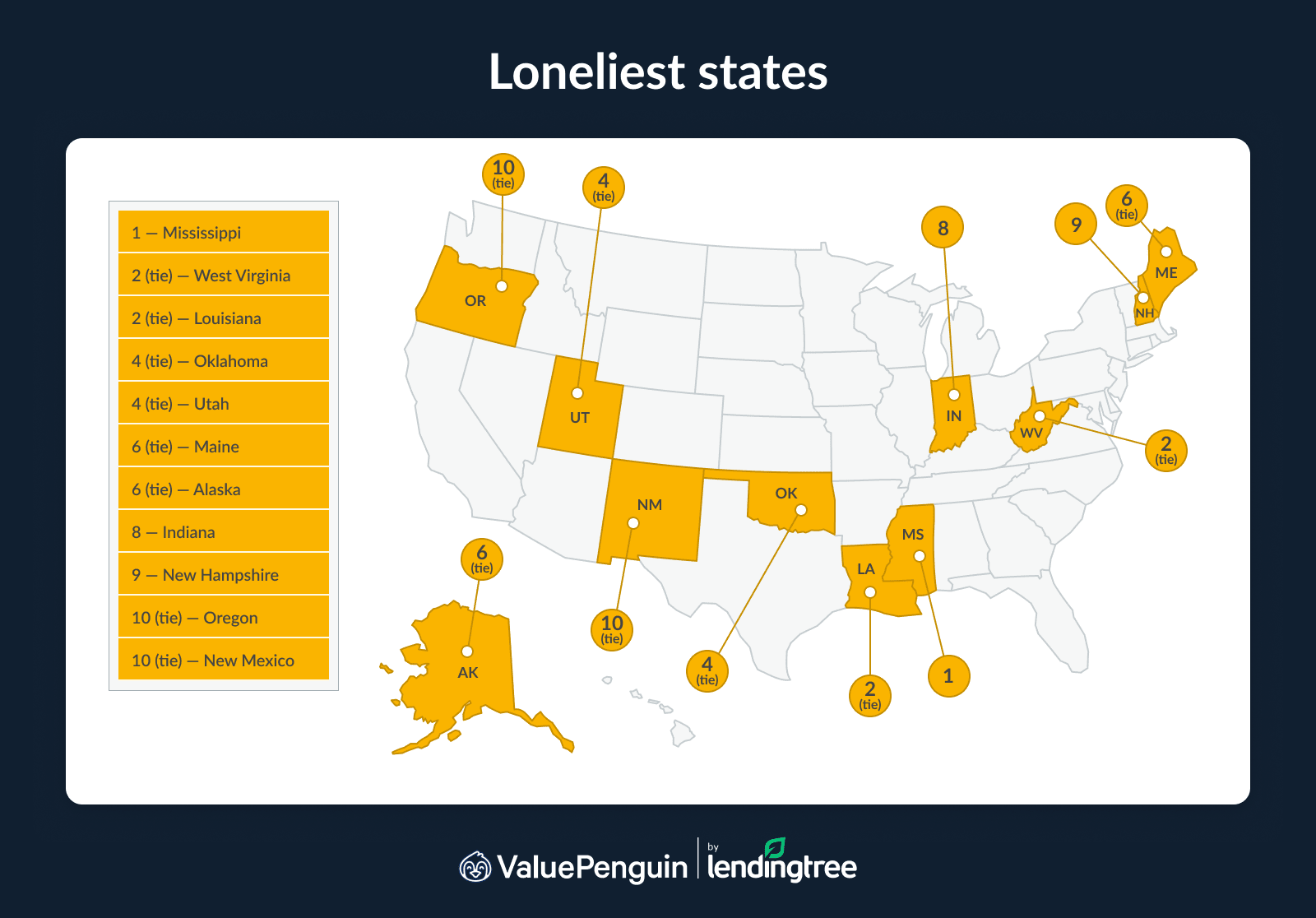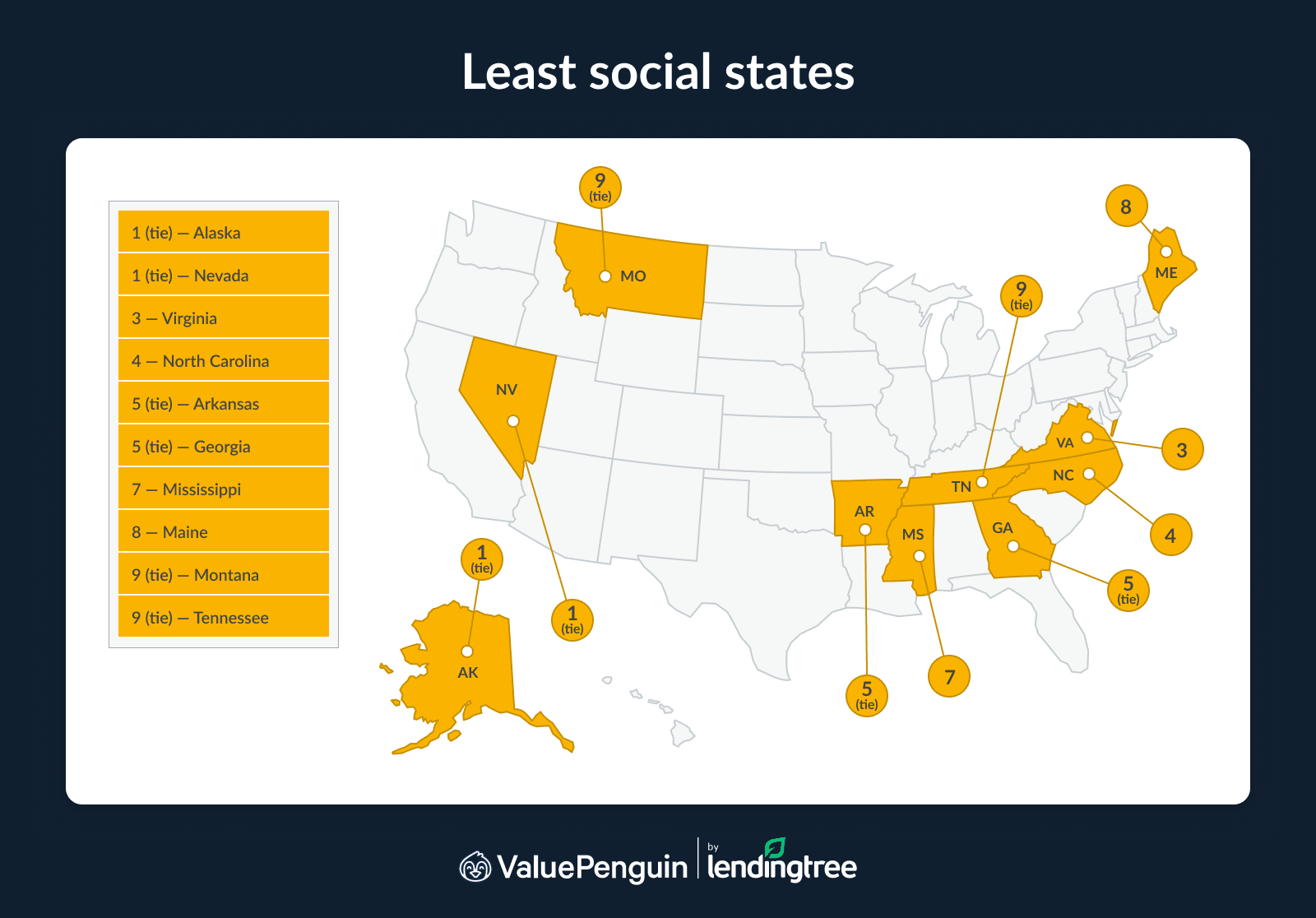Health Insurance
Over 1 in 10 Americans Report They’re Usually or Always Lonely

Loneliness hurts — literally. From higher health care bills to worsened productivity, being lonely can affect all aspects of life. And although we may be more digitally connected than ever, loneliness is particularly rampant, with 13.3% of Americans reporting they usually or always feel it.
We’ll look at the most lonely and least social states.
On this page
Key findings
- On average, 13.3% of Americans report they usually or always feel lonely. By demographic, transgender Americans (36.9%) and adults 18 to 29 (24.2%) report high rates of loneliness.
- Mississippi is the loneliest state. Here, 17.1% of residents report frequent feelings of loneliness. Fellow rural Southern states West Virginia and Louisiana (both 16.1%) tie for second. Meanwhile, New Jersey (11.0%), Hawaii (11.1%) and Illinois (11.2%) report the lowest rates of loneliness.
- Going more than a week without social interaction may contribute to loneliness. On average, 41.4% of Americans don’t socialize with friends or family weekly. That’s again high among transgender Americans (51.4%), while adults 40 to 49 (47.2%) are the most common age group to report this.
- Alaska and Nevada tie as the least social states. In both states, 46.5% of residents don’t socialize weekly. Virginia (44.6%) ranks third. Meanwhile, the District of Columbia (36.7%), Minnesota (37.0%) and Rhode Island (38.0%) have the smallest percentage of residents that go more than a week without socializing.
13.3% of Americans report frequent loneliness
Significant loneliness is common. In fact, 13.3% of Americans report they usually or always feel lonely.
According to ValuePenguin health insurance expert Divya Sangameshwar, loneliness among young adults has steadily increased. "Rates of loneliness among young Americans climbed every year between 1976 and 2019," she says. "Social media influence, economic pressures and general uncertainty have all contributed to these rising rates."
By demographic, transgender Americans (36.9%) are significantly more likely to report frequent loneliness than cisgender women (13.0%) and cisgender men (12.9%). However, those who don’t identify as any of these (29.6%) also have significantly high rates of loneliness.
Meanwhile, adults 18 to 29 (24.2%) have the highest rates by age group, ahead of those ages 30 to 39 (16.5%) and 40 to 49 (13.5%).
Rural states are the loneliest
By state, residents in rural areas are the most likely to report significant loneliness. Mississippi ranks first at 17.1%. West Virginia and Louisiana tie for second at 16.1%.

Conversely, New Jersey ranks last, with just 11.0% reporting frequent feelings of loneliness. Hawaii (11.1%) and Illinois (11.2%) follow closely behind.
Full rankings
Most/least lonely states
Rank | State | % usually or always feeling lonely |
|---|---|---|
| 1 | Mississippi | 17.1% |
| 2 | West Virginia | 16.1% |
| 2 | Louisiana | 16.1% |
| 4 | Oklahoma | 16.0% |
| 4 | Utah | 16.0% |
| 6 | Maine | 15.9% |
| 6 | Alaska | 15.9% |
| 8 | Indiana | 15.3% |
| 9 | New Hampshire | 15.2% |
| 10 | Oregon | 15.1% |
| 10 | New Mexico | 15.1% |
| 12 | Kentucky | 15.0% |
Source: ValuePenguin analysis of U.S. Census Bureau Household Pulse Survey data.
Socialization and loneliness may be related
Socializing may be a major factor in loneliness. A whopping 41.4% of Americans don’t socialize with friends or family weekly.
That rises to over half among transgender Americans (51.4%). Meanwhile, adults 40 to 49 (47.2%) are the most likely age group to report this, followed closely by those ages 50 to 59 (45.2%).
According to Sangameshwar, there are a few reasons why these demographics report the highest rates.
"Transgender individuals often face societal discrimination, rejection or judgment, which can make forming and maintaining relationships challenging," she says. "Many have also lost connections with family members or friends due to non-acceptance of their gender identity. They’re also the most likely to suffer from harassment or violence, which may discourage many from engagement in social settings."
Meanwhile, adults ages 40 to 49 often carry significant responsibilities as they juggle careers, raising children and caring for aging parents. "As they prioritize family or career, experience major life changes, relocate due to jobs or change lifestyle priorities, friendships dwindle," she says. "Societal expectations around independence may discourage lonely middle-aged adults from going out of their way to seek emotional connections, active social engagement or professional help."
Alaska and Nevada are the least social states
By state, two tie at the bottom: Alaska and Nevada, with 46.5% of residents not socializing weekly. Virginia (44.6%) follows.

Conversely, the District of Columbia has the lowest rate of residents who go more than a week without socializing, at 36.7%. Minnesota (37.0%) and Rhode Island (38.0%) rank second and third, respectively.
Full rankings
Least/most social states
Rank | State | % who go more than a week without socializing with friends or family |
|---|---|---|
| 1 | Alaska | 46.5% |
| 1 | Nevada | 46.5% |
| 3 | Virginia | 44.6% |
| 4 | North Carolina | 44.2% |
| 5 | Arkansas | 43.9% |
| 5 | Georgia | 43.9% |
| 7 | Mississippi | 43.7% |
| 8 | Maine | 43.6% |
| 9 | Montana | 43.4% |
| 9 | Tennessee | 43.4% |
| 11 | Connecticut | 43.3% |
| 12 | West Virginia | 43.2% |
Source: ValuePenguin analysis of U.S. Census Bureau Household Pulse Survey data.
Combating loneliness: Top expert tips
Loneliness can impact mental and emotional well-being, but Sangameshwar says there are proactive ways to address it. Here are a few tips to keep the loneliness at bay:
- Build new social connections by joining social groups, clubs or online communities that align with your interests. This includes attending local events, workout classes, workshops or gatherings to meet new people.
- Nurture existing relationships by reaching out to family members, old friends and colleagues to reconnect. This includes scheduling regular catch-ups or activities to strengthen bonds.
- Engage in meaningful activities like volunteering for causes you're passionate about to form connections with like-minded people. Taking up hobbies like painting, cooking, sports or gardening is another way to stay mentally active and connected.
- Seeking help from a professional like a therapist or counselor can help you navigate feelings of loneliness and social isolation. They can also recommend support groups for shared experiences, online or locally.
Methodology
To identify the loneliest states in America, we analyzed the U.S. Census Bureau Household Pulse Survey. Specifically, we examined responses to the question asking how often individuals feel lonely. For each state, we calculated the percentage of respondents who reported feeling lonely "usually" or "always," and ranked states from highest to lowest based on that figure.
A similar approach was used to assess social engagement. We ranked states based on the percentage of residents who reported getting together with friends or family less than once per week, a potential indicator of limited social interaction.
Our analysis draws on three waves of the Household Pulse Survey data:
- Phase 4.0, Cycle 01 (Jan. 9 to Feb. 5, 2024)
- Phase 4.1, Cycle 06 (May 28 to June 24, 2024)
- Phase 4.2, Cycle 09 (Aug. 20 to Sept. 16, 2024)
We averaged results across these three cycles to generate our final rankings.
